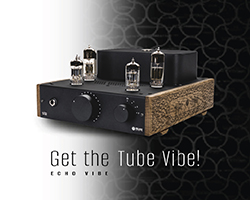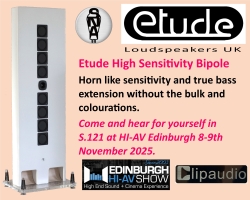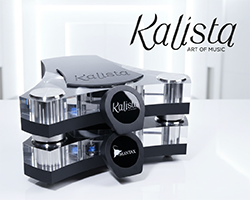CONNECTED-FIDELITY UNITY TWO SPEAKER CABLE REVIEW
Ken Stokes takes a listen to the Unity Two speaker cables from UK-based Connected-Fidelity.
This is the third of my reviews of Connected Fidelity products, I received a bundle to review that included Connected Fidelity’s RF Blockers and AC-K2 Mains Balance Unit as well as these speaker cables. I already said in my prior two reviews that I had a particular interest in reviewing the AC-K2 unit, mains balance was something I have wanted to try for some time. I also mentioned that I’d accepted reviewing the RF Blockers as part of the deal because this was a bundle of items for review. Being completely honest I didn’t expect much from the RF Blockers, however, any preconceived ideas about the RF Blockers were soon dispelled. I ended up buying a pair! I also purchased the review AC-K2 unit from Connected Fidelity so these speaker cables had a tough act to follow given how impressed I am with the preceding kit I had reviewed!
I have personally, and for my own benefit, reviewed and used a fair selection of speaker cables over the years and finally settled on a pair of speaker cables in my rig that have stayed put for a fair length of time, simply put because they work well in my rig. I spent a fair amount of time arriving at a pair that have the synergy that works for me. I’ve dismissed cables at over £4k and liked cables at, well, more realistic prices for me. To be clear, this review is not about if these cables replace my current speaker cables or even if I buy a product I receive for review, it’s about my perception of the build quality and sonic character. The kind of synergy they might offer and what kind of system they might fit well with. We don’t all like, want or even need the same characteristics from particular kit; we don’t all have the same rooms, speakers, amplifiers or budgets and so hopefully my findings will help to assess if these may be the speaker cables for you.
My brief, as always, was to assess using the usual HIFi Pig format and hopefully give some insight for those considering purchasing. Hopefully, my review will offer enough insight to offer some useful guidance.
CONSTRUCTION &SOUND OF CONNECTED-FIDELITY UNITY TWO SPEAKER CABLES
The presentation was very good from the outset, even the box and packaging were impressive. The box was larger than average, think huge pizza dimensions, but with a considerably neater and more stylish finish! Inside the box, the cables I received (2.5m pair) were very well wrapped and protected by foam (I expect that oversized box would happily take a 5m pair). However, packaging while important isn’t really what we are interested in is it? So what of the actual cables? First some basics – mine were supplied with banana fittings at amplifier and spade at speakers. The terminations looked good, all gold plated and fitted with solid metal housings similar to those you might expect of an RCA termination, then sheathed in shrink-to-fit silicon sleeve to a solid metal splitter block. The cables are offered with an option of either spade or banana terminations, both being of good quality and clearly custom-made.
These cables have a striking blue outer PET sleeve with a matching coloured metal ovoid block splitter at each end where the positive and negative conductors emerge from the outer sheath – a very neat, solid finish. The cables themselves are not shrinking violets for placement under carpets, be aware these cables have a greater diameter and are more rigid than most cables – this is mentioned on Connected Fidelity’s website and attributed as part of the resonance damping design of these cables.
There is of course a good deal of information about the construction of these cables on the Connected Fidelity website and I would suggest anyone interested in these cables should look at this for further information.
I prefer not to simply cut and paste from the manufacturer’s website, instead, I’ve paraphrased some key points I think are specifically worth a mention. Notably that in the first instance these cables buck the trend of offering silver-plated copper – these are made from UP-OFC which it is claimed to offer an ultra-pure product that is a cost effective alternative to crystal copper and much purer than standard OFC. Also, further thought to this cable’s dynamics, it is constructed using a selected blend of wire strand conductor diameters totalling 4mm sq. cross-section. The terminations are made from high purity copper, gold plated and sealed with airtight mechanical fixings without any soldering. As already mentioned, these cables have a thicker diameter than most and are fairly stiff (forget wrapping round very tight corners or burying under carpets!). This additional bulk is, I’m told due to generous fibre filling intended to absorb mechanical and airborne resonance, a feature not usually found with cheaper products. Finally, the website also mentions that these cables are cryogenically treated, a process that is claimed to cold anneal wires and connectors offering less coloured audio properties.
For those wanting more technical specification I’ve lifted the following details from the specification on the Connected Fidelity website. Note – I’d be happy if more cable manufacturer’s offered this kind of detail with information about resistance and capacitance etc. I think this is a nice touch, particularly the resistance, capacitance and inductance figures:
- UP-OFC copper multi-sized stranded conductors 2 x 4.0 mm sq.
- Conductor material: ultra-pure oxygen-free copper UP-OFC
- Cross section: 2 x 4.0 mm2
- Resistance: 0.0045 Ω / m
- Capacitance: 99.00 pF / m
- Inductance: 0.6 μH / m
- Outer diameter of cable: 16mm
Finally, one point I think I should mention that does, in my opinion, show the thoughtfulness and flexibility of Michael Osborn at the helm of Connected Fidelity. The speaker cable pair I received were fitted with my usual preference of spade connectors at the speakers. On fitting I found that the spades on the cable pair I had did not fit the binding posts of my Vienna Acoustics speakers (custom binding posts). This raised an issue discussed at length and following those discussions Michael arranged to change the spade connectors offered on these cables to spades with a gap of 8mm rather than the 6mm used on the cables I received. If any customer has any specific requests on this front I would suggest contacting Connected Fidelity. This issue was resolved for me and I feel that it was nice that my pre-review findings were taken on board, resulting in a change of size of spade terminations offered for the range. Also note that Connected Fidelity cables are all handmade in the UK and custom options can be considered for those wishing for custom lengths or fittings.
So to the main course! How did I find these cables in use, and what sort of sonic character did I encounter? Before I received them, Michael Osborn told me that being copper-based, these cables offered a smoother sonic character than is the case with some silvered cables and with slight mid-range warmth. To be fair, and perhaps given that these are Michael’s cables, unsurprisingly I think he hit the nail pretty squarely. However, that was a brief chat and Michael was sensibly avoiding saying too much for fear of swaying my opinion before I even tried them. There is more to this than simply saying smoother with midrange warmth, accurate though that is. I also found these cables to be really quite detailed.
Initially, once I was able to install these cables, I found that although different to my usual system cables, they were in some ways surprisingly similar. It’s not my place to pitch one cable against another, I simply mention this because it gave me a fix of sorts as to where these cables sit twixt lean and bright and warm. I’ve tried cables from each extreme in terms of presentation – very hard and bright to so soft and woolly it would be easy to imagine a blanket had been thrown over my speakers!
As is usual I didn’t want to make any snap decisions without giving a good chance for these cables to settle in my rig. Straight from the box it did feel that I’d not have too much difficulty with these cables, a slight warmth, but still plenty of detail and a smooth top end. Bass still felt solid without any sense that the bottom end was boomy or loose. I simply set about using, no critical listening, and my goal was simply to let them get some hours on them before any specific listening sessions.
I enjoyed having these speaker cables in my system. Once I’d had them in for a good two weeks I decided to start my critical listening and as per my usual routine I played a range of musical genre, albums chosen for specific musical elements; bass depth and range, vocals, upper frequencies, percussive and ambient, complex instrumental mixes and laid bare acoustic etc etc. I noted that these cables offer a very smooth and un-fatiguing presentation. When I conducted my usual retro testing it did become apparent really very quickly that these cables had ‘warmed’ a little from the out of box initial presentation so on that basis I’d strongly recommend that this is borne in mind and some time given before an overall judgement is made. I found these cables to offer a relaxed and gentle presentation, detailed, but not at the expense of lean bass or a lack of depth.
CONCLUSION
The thickness and stiffness of these cables may not suit everyone! if you are looking for something discrete to run under the carpet or round tight bends these are perhaps not the best option. However, they are very well-made cables and are very neatly presented, given that they look as good as they do and are fitted with well-made custom cable splitter and terminations…I know, we are entering the nerd zone discussing good-looking cables, however, this does matter for a fair few HiFi enthusiasts and so is worthy of a mention. Well made, neat, solidly constructed and using quality components.
Sound quality is good with lots of detail and with what I would describe as a very smooth presentation and mid warmth. These cables would fit well in a lot of systems and are difficult to be negative about unless you want a brighter leaner presentation. I’d describe them as sitting fairly in the middle ground in terms of sonic character. That is they are not overly warm or lean and bright. No doubt some of this character is due to the copper conductors rather than silvered copper. I did wonder if the levels of detail were aided by the varied wire conductor wire strands, perhaps an aside discussion, but it did seem to me that in comparison to other ‘all copper’ cables I’ve tried these offer more detail than many, yet still managed to have a smooth presentation.
Michael Osborn, on further discussion, did suggest to me he felt these are cables that suit some of the modern amp designs that can be analytical rather than warm, I did feel this is a fair comment. My amplifier is not a particularly bright or lean amplifier and I’ve always felt that it was close to neutral – and for those familiar with Hypex implementations it does have the wallop expected in lower frequencies and overall detail, but unlike some class D implementations doesn’t have any fatiguing ‘top end’. If my system had had any fatiguing traits I think these Connected Fidelity Unity Two cables may well have been a particularly euphoric installation. As is, there was very little to dislike and much to commend them.
I’d recommend these cables to anyone wanting a slightly smoother presentation. If they fit the budget give these Unity Two cables some consideration.
AT A GLANCE
Build Quality:
Excellent build
The only caveat I’d add is that if you’re looking for a cable to bend around tight corners or bury under carpet these cables are not the best option given their stiffness and diameter. I had no issues in this regard and I’d not expect this to be an issue for many
I’d recommend ordering ‘just long enough’ rather than an extra metre ‘in case’ that might need to be tucked away
This is a cable to show off rather than hide
Sound Quality:
Smooth presentation, un-fatiguing and should sit well in most systems, especially if the user is looking to ease a slightly forward brash presentation in their system.
Value for Money:
I know battles rage about the cost of cables with many claiming anything other than basic is too much. I’d argue that it’s up to the prospective buyer to make that judgement, but I’d happily endorse that these are cables made to a high standard with a custom approach and carefully chosen custom terminations. This kind of attention to detail has to command a premium and in comparison to other companies’ offerings, I believe these Unity Two cables offer good value
We Loved:
Build quality, custom fittings and stylish looks
A smooth and yet detailed sound character
We Didn’t Love So Much:
Stiff thick cables and won’t suit all, especially if tight bends or under carpet routing
Price:
Spade to Spade – £899 (2.5m pair)
Banana to Banana – £849 (2.5m Pair)
Elevator Pitch Review: Well worth a listen if you’re looking for sturdy, well-made cables with quality terminations and a bit of style and with a smooth, but detailed sonic character. Not much to dislike and much to commend. Would sit well in lots of systems and offer no overly bright or fatiguing edges. An easy choice!
SUPPLIED BY CONNECTED-FIDELITY

Ken Stokes
Review Equipment: Roksan Caspian M2 CD player (transport only), MacBook Pro using Audirvana for ripped FLAC files and Qobuz Studio for streamed. Benchmark Dac3 Pre / Dac to Nord NC500 MK2 spec’ Dual Mono Power Amp, Vienna Acoustics Beethoven Baby Grand SE Speakers, Chord Epicx speaker cable used in conjunction with Connected Fidelity RF Blockers, Tellurium Q Black XLR, Chord EpicX digital coax and Chord EpicX USB, Mains – Belden DIY Screened Mains Cables, Connected Fidelity AC-2K mains balance Unit.

















































































































































































































